 Written by Brittany Ferri, OTR/L
Written by Brittany Ferri, OTR/L
Generally speaking, bariatric is a term that relates to the specialty of obesity treatment. This area of medicine is rapidly growing. The nationwide prevalence of people living with obesity has increased from 30.5% to 41.9% since 2000.
Similar to other health conditions, people with obesity often require specific medical treatments, equipment, and therapies. For example, bariatric surgery is weight loss surgery that restructures the digestive system of a person living with obesity to help them eat less and lose weight. People with obesity may also participate in bariatric fitness programs to help start or maintain weight loss.
In terms of equipment, people with obesity often require bariatric walkers or bariatric wheelchairs, which both have a higher weight capacity to accommodate people with obesity who have mobility impairments. While these are some of the most common equipment for people living with obesity, a range of products can meet their medical needs.
Bariatric is a descriptive term used to describe anything related to the treatment and specialization of bariatric medicine. Bariatric medicine is the field of obesity treatment, which helps people with obesity to lose weight and manage obesity-related health concerns.
Someone is considered obese based on their body mass index (BMI). BMI is a value of body fat, which is calculated by dividing a person’s weight by their height. The exact number of pounds varies depending on how tall someone is, so obesity itself is not a specific weight. However, people with obesity have a BMI of 30.0 or higher.
For medical devices, bariatric is usually over 500 pounds.
Bariatric-friendly is a term that describes anything acceptable for and accommodating of people living with obesity. For example, medical equipment that is “bariatric friendly” probably has a higher weight capacity, is constructed with durable materials, and is probably overall larger.
We mentioned bariatric equipment, such as walkers and wheelchairs, earlier. These are just two examples of equipment (also known as durable medical equipment or DME) that can aid a bariatric population. When browsing these products, you might often see the words ‘heavy duty’ in item descriptions. The words ‘heavy duty’ and ‘bariatric’ are interchangeable. They both refer to items with an increased weight capacity.
Bariatric wheelchairs are an option for people with obesity who have severe mobility impairments and cannot get around. These wheelchairs have many of the same features as standard manual wheelchairs but are more heavy-duty to accommodate bariatric needs. Bariatric wheelchairs are typically made of steel to increase their durability, while standard wheelchairs are aluminum with some steel components.
Bariatric wheelchairs offer features much like standard wheelchairs (hand brakes, footrests of various styles, storage pouches, and more) but often have more lumbar support to allow for better positioning. Standard wheelchairs have weight capacities between 250 and 350 pounds. Usually, bariatric wheelchair models can accommodate 500 to 700 pounds, and there are some out there that go up to 1,000 pounds. Bariatric wheelchairs are also wider: heavy-duty models can be up to 36 inches wide, while standard wheelchairs are between 16 and 20 inches wide.
If you want to view some of our best bariatric wheelchairs, check out 8 Best Heavy Duty Power Wheelchairs and Best Heavy Duty Bariatric Manual Wheelchairs.
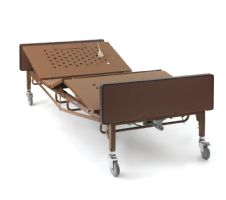 | Medline MDR107004 Bariatric Home Hospital Bed View Product |
Bariatric hospital beds can handle up to 500 pounds compared to standard hospital beds, which accommodate up to 300 pounds. Similar to bariatric wheelchairs, bariatric hospital beds are also made of steel to provide proper reinforcement. Standard hospital beds are a combination of steel and plastic and usually weigh around 150-175 pounds. Due to the heavier metals, bariatric hospital beds weigh closer to 300 pounds.
Bariatric hospital beds have similar features to standard ones: emergency manual cranks, remote height adjustment, various head and feet positions, and more. Bariatric hospital beds are also extra wide at 54 inches wide and up to 90 inches long. This feature offers much more sleeping space than standard hospital beds, which are no more than 36 inches wide and 80 inches long.
Read about our 6 Best Bariatric Hospital Beds for more information on these products.
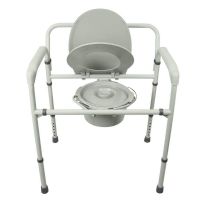 | Vive Health Bariatric Commode for Bedside Toileting 500 lbs View Product |
There is less variety in the features of commodes simply due to the nature of the equipment. Commodes of any kind serve as basic frames to allow individuals access to a raised seat and attached armrests while using the bathroom.
Despite their simple design, bariatric commodes are steel, and they usually have a weight capacity of ~500 to 600 pounds. This figure is double that of standard commodes, which have a weight capacity of up to 300 pounds and consist of lightweight aluminum. Check out our Vive Bariatric Commode Review to find out why that is our favorite bariatric bedside commode!
Standard commodes offer a seat width of 14 inches, while bariatric models have much more room at 23 inches wide. Due to their basic construction, both commode models weigh between 20 and 25 pounds.
It’s important to note that these commodes are for toilets since there are other styles for the shower. If you’re looking for either of these models, you can view our Bariatric Shower Commode Chairs and Bariatric Commodes.
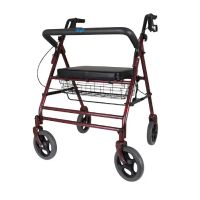 | Days 111 Bariatric Rollator 700 lbs View Product |
Bariatric rollators have built-in seats just as standard rollators do. Other features are similar across the two models: hand brakes, hidden storage, swiveling front wheels, and a front-facing safety bar to support a person’s back when they sit.
However, most bariatric rollators can handle up to 450 pounds compared to 250 for a regular rollator. Since it’s more durable, it’s no surprise that bariatric rollators are made of steel while standard rollators are aluminum. Bariatric rollators have seat widths between 27 and 29 inches wide, which offers slightly more room than standard rollators at 24 to 25 inches wide. Those who want more guidance when selecting a bariatric rollator can look at our Top Rated Bariatric Rollators.
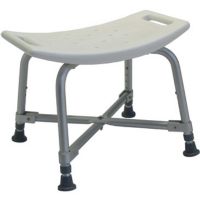 | Lumex Bariatric Bath Seat by Graham Field View Product |
Bath benches offer individuals seating within a shower or tub so they can bathe without worrying about mobility concerns. Bariatric bath benches and standard benches offer removable and adjustable back support and one or two lateral handles. All bath benches are aluminum. However, bariatric models have a capacity of up to 500 pounds, while standard ones can accommodate between 200 and 300 pounds. Most bariatric benches are around 20 inches wide, which offers several more inches than standard benches at 14 inches wide. You can view RehabMart’s selection of bariatric bath benches.
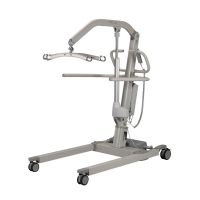 | FGA-700 Bariatric Mobile Floor Lift View Product |
Individuals with obesity who cannot move around their environment will need a bariatric lift. These lifts are caregiver-operated and can handle between 500 and 1,000 pounds. Bariatric lifts are typically steel and operate with the help of a motor, battery, or hydraulic power. Standard patient lifts accommodate up to 400 pounds and have similar mechanisms. These lifts are steel and aluminum and rely on a caregiver to run the equipment.
While the lifts are mainly the same, the fabric slings that patients sit in may differ. Bariatric lifts often come with full-body, heavy-duty slings with more reinforcements to offer added security. Standard slings are usually made of mesh and cover less surface area while mainly focusing on cradling the head and buttocks for safe transfer. Check out our selection of Bariatric Patient Lifts for sale.
 | Solace Resolution Glissando Heavy Duty | Mattress by Invacare View Product |
Some people living with obesity need bariatric hospital beds compatible with bariatric mattresses. These mattresses can handle up to 750 pounds and are high-resistance foam that stands the test of time. You can check out our selection of bariatric mattresses for sale.
Standard mattresses may be foam, air pockets, gel pouches, inner springs, or any combination of these materials. These mattresses can tolerate up to 250 pounds. The width of each mattress depends on the size bed, with twins coming in at 38 inches wide and kings at 76 inches wide.
Mattress measurements have no bearing on its weight capacity. However, if you don’t select a mattress from the same company as your hospital bed, you should be sure their measurements and other specifications match up for the best fit.
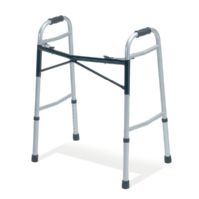 | Bariatric Walker by Medline 650 lbs View Product |
Walkers are often known as front-wheeled walkers due to their two front wheels and bare rear legs. Front-wheeled walkers are slower and more stable than rollators and do not have a convertible seating option. Standard walkers have a weight capacity of 350 to 400 pounds, while bariatric walkers can accommodate up to 750 pounds. Browse our entire selection of Bariatric Walkers for sale.
Features are the same across the board with hand grips, push levers to fold the walker, and the option for accessories such as storage pouches, mirrors, and more.
Bariatric walkers have a steel-aluminum alloy frame; standard walkers are more lightweight due to their aluminum construction. Bariatric walkers are between 25 and 27 inches wide, while standard walkers are slightly smaller at 18 to 22 inches wide.
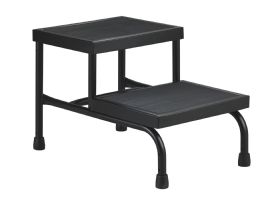 | Bariatric Two-Step Step Stool View Product |
People with obesity can benefit from bariatric step stools to help them more easily access certain areas, such as high kitchen cabinets and closet shelving. These bariatric step stools have rubber grips for stability, dual handles, and solid platforms. Bariatric step stools can accommodate 500 pounds, are made of steel, and can be up to 23 inches wide. People with obesity who want added stability when completing chores can shop our bariatric step stools.
Standard step stools are also steel but tend to be around 10 to 12 inches wide. These models can handle between 200 and 300 pounds and typically have the same features as bariatric versions.
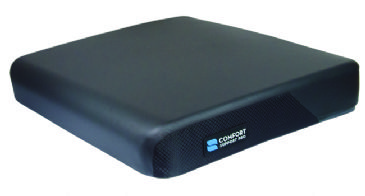 | Support Pro 7 Series - Bariatric Cushion by Comfort Company View Product |
Individuals with obesity who use bariatric wheelchairs also need bariatric wheelchair cushions to relieve pressure on their skin. Bariatric cushions are 20 to 30 inches wide and have gel, foam, or air layers. The exact weight capacity depends on the cushion’s material: foam and air can handle 700-750 pounds; gel can withstand up to 500 pounds. Some custom-made cushions can even handle up to 1,000 pounds. It’s best to get the most appropriate cushion for your wheelchair, so be sure to check your measurements before viewing our bariatric wheelchair cushions for sale.
Standard cushions have a much lower weight capacity also based on material. Gel cushions can handle up to 250 pounds, while foam cushions can handle around 400 pounds. These cushions are usually between 16 and 18 inches wide.
 | Bariatric Steel Black Quad Cane by Medline 500 lbs View Product |
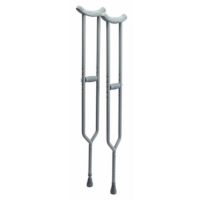 | Lumex Bariatric Imperial Underarm Steel Crutches by Graham Field View Product |
Bariatric crutches and canes are steel equipment that supports people with obesity who have trouble getting around. Bariatric canes are better suited for individuals with chronic mobility concerns, while bariatric crutches are a good option for obese individuals recovering from leg, knee, or foot injury. Bariatric crutches only weigh 1 to 3 pounds but can support up to 500 pounds. Bariatric canes weigh around 2 pounds and can handle up to 600 pounds. Take a look at our selection of bariatric canes and crutches for sale.
Bariatric crutches and canes have the same features as standard models. Canes have single or quad tips for added stability with an ergonomic handle and, in some cases, a lower handle to help someone going from sitting to standing. Crutches traditionally have padded forearm cradles and adjustable grips. Some models also have straps for more security. Standard crutches and canes are aluminum.
As you can see, there can be some variation between bariatric and standard equipment. In most cases, the higher weight capacity of bariatric equipment comes from its steel construction. However, this means the devices are likely heavier, which users and caregivers should consider when shopping. Among bariatric and standard durable medical equipment, features are mostly the same for ease of use. To learn more about bariatric devices and other equipment, visit the Caregiver University blog for more articles.

Brittany is an occupational therapist who has worked in a variety of rehab facilities. She has always expressed an interest in patients’ internal motivation for therapy and the use of assistive devices, which led her to pursue a PhD in Integrative Mental Health. This research-based training has also led her to develop her writing career to educate patients of all ages on how to improve their health. Brittany has published four books, written over 300 articles, and has been quoted in media outlets such as WebMD, Healthline, and NBC News.